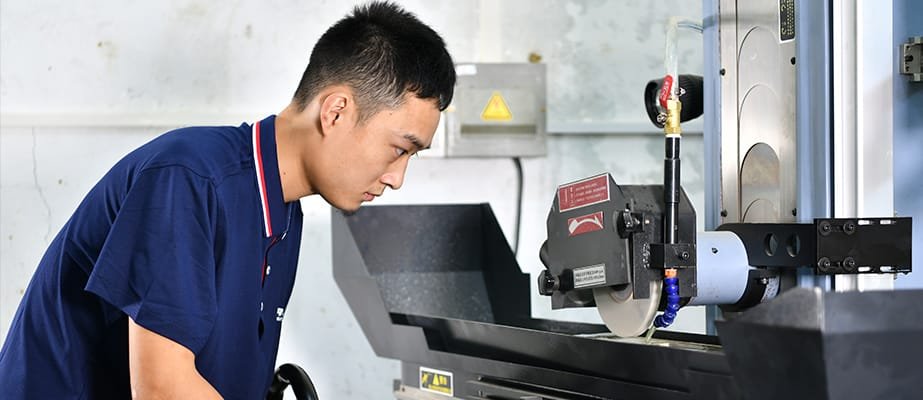Overview of Machinable Glass Ceramics
Often represented by Corning’s Macor trademarked products, machinable glass-ceramics are a unique material that fills the gap between traditional engineering materials such as ceramics and metals. Its main feature is its machinability, which allows it to be shaped into complex geometries without the need for diamond tools or sintering processes. But what makes this material so revolutionary? Let’s take a closer look at its properties, machining techniques, and applications.

Composition
Machinable glass-ceramic is a composite material made primarily of fluorphlogopite and borosilicate glass. Its microstructure consists of a network of randomly oriented mica flakes within a glass matrix, which gives it excellent machinability and thermal stability. This composition makes machinable glass-ceramic an alternative to conventional ceramics in high-precision applications.
Key Properties of Machinable Glass-Ceramics
1.Thermal stability
Operating Temperature: Machinable glass ceramics can withstand continuous use temperatures up to 800°C in air and 1000°C in a vacuum environment.
Thermal Expansion: Its coefficient of thermal expansion (CTE) is similar to that of most metals, minimizing thermal mismatch in assemblies. Typical CTE: ~9.3 x 10^-6/K.
2.Electrical insulation
Excellent dielectric properties make it the preferred choice for high voltage and radio frequency applications.
Dielectric strength: up to 40kV/mm.
Volume resistivity: greater than 10 ^ 14 Ω· cm at room temperature.
3.Good processability
Can be machined using standard tungsten carbide or HSS tools.
No post-machining sintering or firing is required, reducing preparation time and costs.
4.Chemical resistance
Resistant to most acids and solvents, but not recommended for prolonged exposure to strong bases or hydrofluoric acid.
5.Dimensional stability
The extremely low porosity and consistent material density ensure high dimensional accuracy even under thermal cycling.
How to Process Machinable Glass Ceramics
Machinable glass ceramics are designed for easy processing and can achieve complex designs without facing the challenges brought by traditional ceramics

1.Tools used
Most applications can use standard high-speed steel (HSS) or tungsten carbide tools.
Avoid using diamond coated tools as they may cause excessive wear due to the glass matrix of the material.
2.Processing Guide
Speed and feed: It is recommended to use medium speed and feed to avoid fragmentation.
Coolant: Using water-based coolant can minimize heat accumulation and prevent microcracks.
Drilling: When drilling, ensure appropriate clearance angles to reduce stress on the material.
Threading and tapping: Glass ceramics can be processed with fine threading without cracking; However, excessive torque should be avoided.
3.Organizing techniques
After processing, the edges may need to be polished to remove microcracks.
Using diamond polishing paste can achieve a mirror like effect.
4.Avoid overheating
Overheating during the processing can cause local thermal stress, leading to cracking. Maintain a low thermal gradient throughout the processing.
Applications of Machinable Glass Ceramics
Aerospace and Defense
Thermal insulation: Due to its high thermal stability, it can be used for heat shields and thermal barriers.
High voltage insulator: Its excellent dielectric properties make it an indispensable material in satellite and spacecraft systems.
Electronics and Optics
Substrate: Due to its dimensional stability, it is highly suitable for microelectronics and optoelectronics.
Optical components: used for manufacturing lenses, laser mounts, and optical collimation systems
Medical Equipment
Commonly used in high-precision diagnostic equipment such as X-ray machines and CT scanners.
Its biocompatibility makes it suitable for surgical instruments and implants.
Industrial Applications
Chemical treatment: acid resistant, making it the preferred material for customized laboratory vessels.
Vacuum environment: Due to its low exhaust characteristics, it is commonly used in vacuum systems.
Prototype Design
Due to the fact that machinable glass ceramics do not require subsequent processing, they are widely used for rapid prototyping of ceramic parts.
Machinable Glass Ceramic vs Traditional Ceramics
Machinable Glass Ceramic Manufacturer
Jundro Ceramics provides standard and customized sizes for industrial customers. Make it an ideal choice for various high-precision equipment, such as rods, if you need them, For plates, sheets, or prototype production, please contact our experts. We are happy to provide you with our services
FAQs About Machinable Glass Ceramic
Can machinable glass ceramic be used in vacuum environments?
Yes, it performs exceptionally well in high-vacuum environments due to its low outgassing and thermal stability up to 1000°C.
Is Macor the only machinable glass ceramic available?
Macor is the most well-known brand, but other manufacturers produce similar materials with comparable properties.
What is the best coolant to use during machining?
Water-based coolants are ideal as they minimize heat buildup and prevent cracking.
